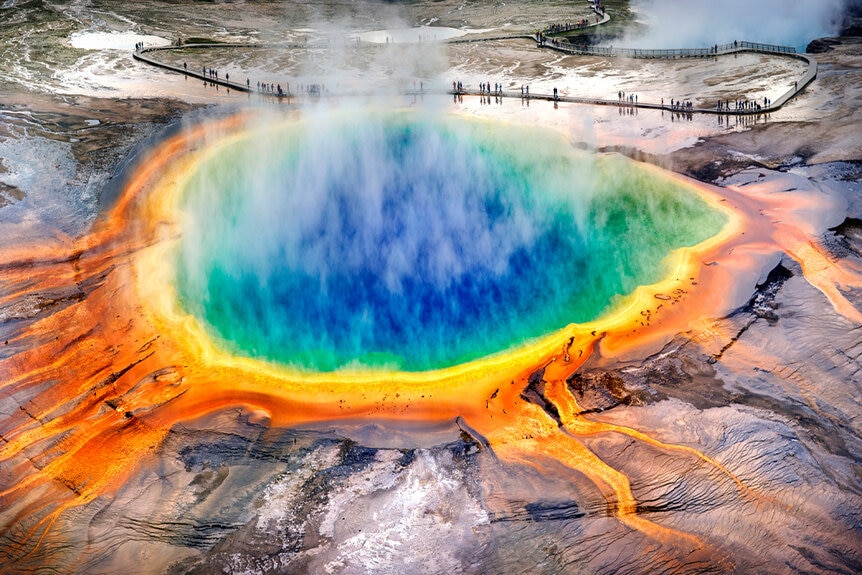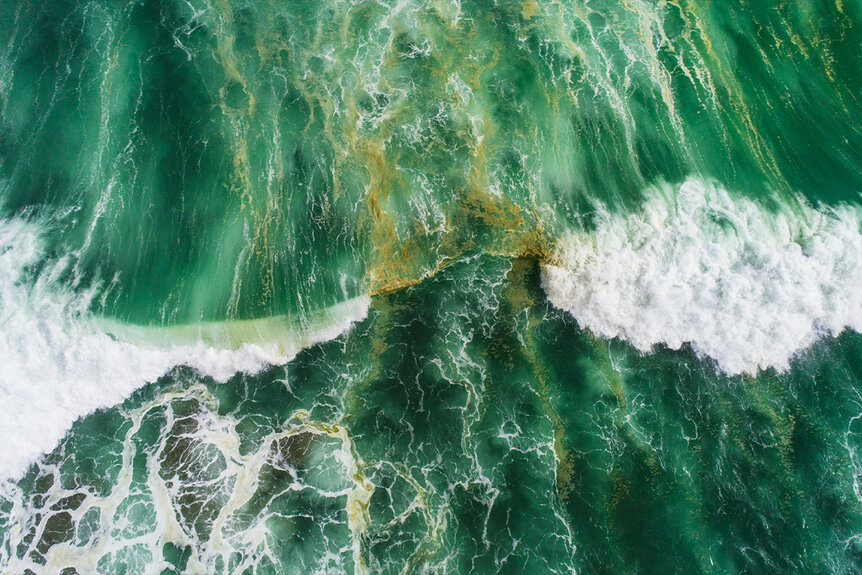Create a free profile to get unlimited access to exclusive videos, sweepstakes, and more!
Our Pale Blue Dot Is Turning Green, Thanks to Climate Change
Green oceans are pretty, but pretty bad otherwise.
SYFY's The Ark (streaming now on Peacock) takes place 100 years in our future, when our survival on the Earth is no longer assured. The prevailing wisdom is that if we want to continue existing long-term, we’re going to have to spread to as many planets as possible. There are half a hundred reasons we might need to abandon the Earth in favor of other cosmic islands, which is why some real-world scientists have called for humanity to become a multi-planet species.
Dramatic world enders like a massive asteroid or global nuclear war could certainly transform the Earth into a hostile world, but those are only abstract possibilities. They might happen in the future, and they might not, but one thing is certain to make our planet less hospitable and it’s already happening. Climate change is transforming the face of our planet, extinguishing some species while bolstering others, and altering the color of the world’s oceans, according to a new study published in the journal Nature.
Greener Oceans: A Climate Canary
We think of the oceans as being blue, as if the color is an inherent quality of the waters they are made of, but the color of oceans and other bodies of water can change from place to place and over time. The color of water depends on a number of characteristics including the concentrations of certain elements like iron and populations of phytoplankton, algae, and other microbes.
RELATED: Snowpiercer’s Climate Engineering Could Help Us to Refreeze Earth’s Poles in Real Life
We need only look at the hot springs at Yellowstone to see how the color of water can teach us about what’s going on inside. The famous Grand Prismatic hot spring transitions from clear blue in its center to fiery orange at its edges, and those colors come largely from populations of bacteria living at different points along a temperature gradient spreading out from the spring’s center. The spring’s rainbow of color clearly indicates where different types of bacteria are living and how well they are doing. Something similar, albeit less dramatic, happens in the world’s oceans.
When we look at the oceans, we’re seeing the blue of the water but we’re also seeing the green of all the plant life living in the water. Populations of phytoplankton and algae naturally fluctuate over time, and scientists wondered if they could use those fluctuations to track the progress of climate change. Their thinking was that the average color of the ocean might be an indicator of climate health because it correlates with the health of photosynthesizing populations.
Measuring the Color of the World’s Oceans
There were a couple of challenges inherent in the task. The first is that there are a number of satellites observing the oceans, but each of them works in a slightly different way, looking at different parts of the light spectrum. Which unfortunately means that their data can’t be easily combined. The other challenge is the phytoplankton and algae, themselves.
Because the amount of green they’re adding to the oceans naturally ebbs and flows with the seasons and the years, as their populations rise and fall, it can be challenging to pick up the background signal driven by something like climate change. To correct for those everyday fluctuations, researchers gathered data over a 20-year period.
Researchers gathered data using the Moderate Resolution Imaging Spectroradiometer (MODIS) aboard the Aqua satellite. Aqua was launched in 2002 and has been observing the world’s oceans for the last two decades. Poring through the data it has collected, scientists were able to see larger changes in the average color of oceans over 20 years. They found that 56% of world oceans were significantly greener. Changes in color were largely concentrated within 40 degrees north or south of the equator. Changes were easier to see there, because tropical waters experience fewer seasonal changes, making the background signal easier to identify.
How We Know Climate Change Is Causing the Oceans to Change Color
There are plenty of reasons phytoplankton and algae might have a population explosion and shift the color of the oceans toward a greener hue. Nutrients released from underwater vents, extreme weather events, and even higher than usual fish populations can all lead to a rapid increase of phytoplankton and algae.
To check their results, researchers created a computer model which measured specifically how populations of phytoplankton and algae might respond to an increase in greenhouse gases. The idea is to see what sort of signal we could expect to measure, irrespective of any other natural pressures.
RELATED: How the world could end, the science behind 'Knock at the Cabin'
When they bounced their simulation against the actual change measured by MODIS and Aqua, they matched almost exactly. If the oceans aren’t getting greener because of climate change, they’re acting exactly as though they are.
The study stands as a proof of concept that oceanic plant populations, as measured by the amount of green they’re adding to the oceans’ color palettes, can indicate overall climate health. Next steps involve additional data sets, including the launch of NASA’s Plankton Aerosol, Cloud and Ecosystem (PACE) satellite, scheduled for launch in January 2024.
We should probably do something about climate change now, before we have to jump ship to Proxima centauri b like they've done on The Ark. Catch the complete first season, streaming now on Peacock!




































